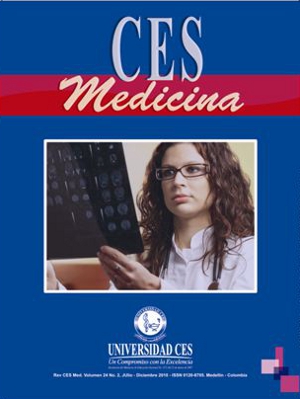PREVALENCIA Y CARACTERIZACION CLINICA DE PACIENTES CON DISFAGIA EN UNIDAD DE CUIDADOS ESPECIALES
Resumen
Introducción: la disfagia, que se define como la dificultad para deglutir los alimentos, se presenta a cualquier edad y puede tener un origen orgánico, cuando responde a alteraciones estructurales; o funcional, si altera la sinergia del mecanismo de la deglución. La disfagia debe ser diagnosticada lo antes posible y valorada por un especialista para poner en marcha técnicas de deglución seguras y estrategias dietéticas y de alimentación adecuadas.
Objetivo: identificar pacientes con trastornos de la deglución, en una unidad de cuidados especiales y caracterizar las causas directas de dichos trastorno.
Sujetos y métodos: se evaluaron 31 pacientes ingresados en una unidad de cuidados especiales La metodología diseñada incluyó la toma de datos de la historia clínica sobre el diagnóstico y motivo de hospitalización y la aplicación de un instrumento para la evaluación de la deglución.
Resultados: los diagnósticos de los pacientes evaluados fueron: cáncer 29 %, ECV 12,9 %, EPOC 12,9 %, TEC 6,5 %. La prevalencia de la disfagia fue 35,5 %, y 29 % tenían riesgo de bronco aspiración y requerían uso de sonda para nutrición.
Conclusiones: los indicios más frecuentes para detectar el trastorno en la deglución fueron dificultad en el manejo de las propias secreciones, voz húmeda, latencia en preparar el bolo y lentitud en la elevación laríngea. Los pacientes con mayor tiempo de estancia hospitalaria tuvieron ventilación mecánica prolongada y dificultades para nutrición por vía oral.
ABSTRACT
Introduction: Dysphagia is defined as a difficulty to swallow food that can be either organic or functional in origin. In the former case, it´s caused by tumors or structural alterations of congenital nature; in the latter case, it affects the synergy of the swallowing process, and can appear at any age. Dysphagia must be diagnosed as quickly as possible, and a specialist must assess it in order to implement safe swallowing techniques and appropriate dietetic and nutrition strategies.
Objective: to identify the patients of a special care unit who suffer from swallowing disorders and to characterize the direct causes of such disorders by using the data recorded in their evaluation and clinical history.
Subjects and methods: we assessed 31 patients from a special care unit (14 were male and 17 female) whose ages ranged from 18 to 88. Data regarding diagnosis and reasons for hospitalization were taken from the clinical history. Likewise, an instrument was used for swallowing assessment.
Results: the diagnosis for the assessed patients was: Cancer: 29 %, CVD 12.9 %, COPD 12.9 %, TBI 6.5 %. The prevalence of dysphagia was 35.5%, and 29 % of the subjects had risk of bronchoaspiration, thus requiring a catheter for feeding.
Conclusions: the most frequent indications for the presence of swallowing disorders were: difficulty to handle one’s own secretions, wet voice, delay in preparing the bolus, and slow laryngeal elevation. Patients with longer hospital stay had prolonged mechanical ventilation and difficulty to feed orally.
Descargas
Descargas
Publicado
Cómo citar
Número
Sección
Licencia
Derechos de reproducción (copyright)
Cada manuscrito se acompañará de una declaración en la que se especifique que los materiales son inéditos, que no han sido publicados anteriormente en formato impreso o electrónico y que no se presentarán a ningún otro medio antes de conocer la decisión de la revista. En todo caso, cualquier publicación anterior, sea en forma impresa o electrónica, deberá darse a conocer a la redacción por escrito.
Plagios, duplicaciones totales o parciales, traduccones del original a otro idioma son de responsabilidad exclusiva de los autores el envío.
Los autores adjuntarán una declaración firmada indicando que, si el manuscrito se acepta para su publicación, los derechos de reproducción son propiedad exclusiva de la Revista CES Medicina.
Se solicita a los autores que proporcionen la información completa acerca de cualquier beca o subvención recibida de una entidad comercial u otro grupo con intereses privados, u otro organismo, para costear parcial o totalmente el trabajo en que se basa el artículo.
Los autores tienen la responsabilidad de obtener los permisos necesarios para reproducir cualquier material protegido por derechos de reproducción. El manuscrito se acompañará de la carta original que otorgue ese permiso y en ella debe especificarse con exactitud el número del cuadro o figura o el texto exacto que se citará y cómo se usará, así como la referencia bibliográfica completa.
| Estadísticas de artículo | |
|---|---|
| Vistas de resúmenes | |
| Vistas de PDF | |
| Descargas de PDF | |
| Vistas de HTML | |
| Otras vistas | |



